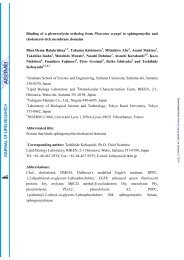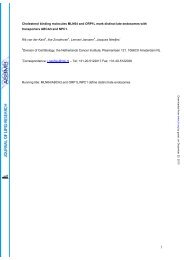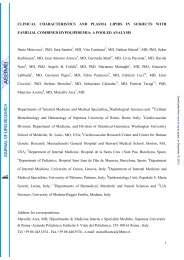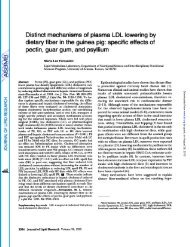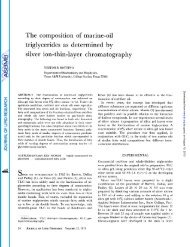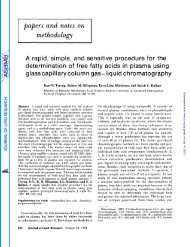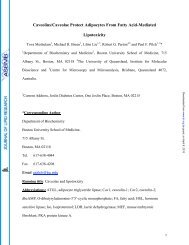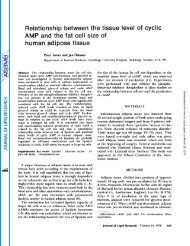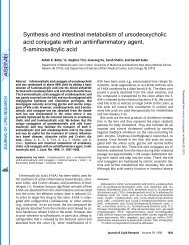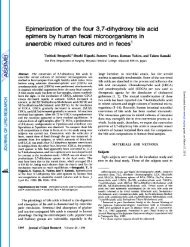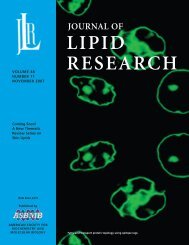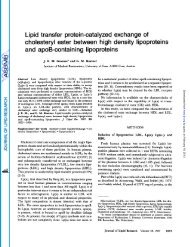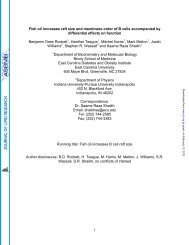Cholesterol gallstone dissolution in bile - The Journal of Lipid ...
Cholesterol gallstone dissolution in bile - The Journal of Lipid ...
Cholesterol gallstone dissolution in bile - The Journal of Lipid ...
Create successful ePaper yourself
Turn your PDF publications into a flip-book with our unique Google optimized e-Paper software.
e derived from equilibrium <strong>dissolution</strong> experiments<br />
(see Fig. 6A and 6B).<br />
Influence <strong>of</strong> <strong>bile</strong> salt type<br />
Dissolution with CDC and its conjugates was markedly<br />
faster than with UDC and its conjugates under<br />
all circumstances. <strong>The</strong>se results can <strong>in</strong> part be expla<strong>in</strong>ed<br />
by the greater capacity <strong>of</strong> the CDC series to<br />
solubilize cholesterol. In fact as shown <strong>in</strong> Fig. 14, when<br />
all <strong>of</strong> the common <strong>bile</strong> salts are compared, the <strong>in</strong>itial<br />
<strong>dissolution</strong> rates correlate directly with equilibrium<br />
cholesterol solubility irrespective <strong>of</strong> the <strong>bile</strong> salt<br />
species and crystall<strong>in</strong>e form <strong>of</strong> cholesterol.6 It<br />
<strong>in</strong>terest that the rank-order<strong>in</strong>g <strong>of</strong> <strong>dissolution</strong> rates<br />
is <strong>of</strong><br />
is CDC series > DC: series > C series > UDC series<br />
and <strong>in</strong> all cases free <strong>bile</strong> salts are faster than G-<br />
conjugates which <strong>in</strong> turn are faster than T-conjugates.<br />
S<strong>in</strong>ce the <strong>dissolution</strong> rates <strong>of</strong> each <strong>bile</strong> salt series fall<br />
on separate curves, it is obvious that other physical-<br />
E(w/LIBQlUiW Chl7L ESTE6QL SOLLLSILITY<br />
fmMl<br />
chemical properties <strong>of</strong> the <strong>bile</strong> salts significantly<br />
<strong>in</strong>fluence their cholesterol <strong>dissolution</strong> rates. It is un-<br />
Fig. 14. Relationship between the <strong>in</strong>itial <strong>dissolution</strong> rates <strong>of</strong> both<br />
ChA and ChM by the common <strong>bile</strong> salt species <strong>of</strong> man, C, DC, CDC,<br />
likely that the variations <strong>in</strong> micellar size and diffusion UDC, and their T and G conjugates and equilibrium cholesterol<br />
solubilities <strong>in</strong> 100 mM <strong>bile</strong> salt solutions (0.15 M Na+, 37°C). ChM<br />
coefficients <strong>of</strong> the micelles (34) are responsible for solubilities <strong>in</strong> the C and DC series were measured by <strong>dissolution</strong><br />
these results s<strong>in</strong>ce the present studies were carried out to equilibrium (M. J. Armstrong and M. C. Carey. Unpublished<br />
at 300 r.p.m. where micellar diffusion would play only observations).<br />
a m<strong>in</strong>or role <strong>in</strong> controll<strong>in</strong>g the overall <strong>dissolution</strong><br />
rate. <strong>The</strong>refore, we suggest that different <strong>in</strong>terfacial that micellized <strong>bile</strong> acids and cholesterol compete for<br />
reaction rates are the predom<strong>in</strong>ant factors responsible b<strong>in</strong>d<strong>in</strong>g sites with<strong>in</strong> micelles. S<strong>in</strong>ce GUDC has a high<br />
for variations <strong>in</strong> the <strong>dissolution</strong> rates shown <strong>in</strong> Fig. precipitation pH (9) and predom<strong>in</strong>ates <strong>in</strong> <strong>bile</strong> <strong>of</strong> pa-<br />
14. In the case <strong>of</strong> the cholelitholytic species, when tients on UDC therapy, this suggests that a slightly<br />
the data for UDC/GUDCYTUDC and CDC/GCDC/ acid gallbladder <strong>bile</strong> might be <strong>in</strong>imical to the success<br />
TCDC are plotted semilogarithmically, they fall on <strong>of</strong> <strong>dissolution</strong>. We have previously discussed (9) how<br />
two separate l<strong>in</strong>ear regressions (not shown). <strong>The</strong> dis- taur<strong>in</strong>e feed<strong>in</strong>g should <strong>of</strong>fset this disadvantage, a<br />
solution rate for the UDC series is 1.32 mmoles. suggestion further re<strong>in</strong>forced by our data <strong>in</strong> Fig. 7A.<br />
ern-'. sec" per 1 mM <strong>in</strong>crement <strong>in</strong> cholesterol solubil- As was previously shown by Kwan et al. (25) and<br />
ity versus 2.1 mmoles .cm-2 .set" per 1 mM <strong>in</strong>crement confirmed here, <strong>in</strong>creases <strong>in</strong> both <strong>bile</strong> salt and neutral<br />
<strong>in</strong> solubility for the CDC series. This suggests that electrolyte concentrations promote dramatic <strong>in</strong>creases<br />
the <strong>in</strong>terfacial reaction rate may well be slower <strong>in</strong> the <strong>in</strong> <strong>dissolution</strong> rates (Fig. 7B, Fig. 8A and B). In the<br />
case <strong>of</strong> <strong>dissolution</strong> with the UDC series. Direct rotat<strong>in</strong>g former case, <strong>dissolution</strong> is enhanced by the <strong>in</strong>crease<br />
disk experiments will be necessary to confirm this <strong>in</strong> the capacity <strong>of</strong> the system to solubilize cholesterol.<br />
possibility.<br />
In fact, the slopes <strong>of</strong> the data <strong>in</strong> Fig. 8 clearly <strong>in</strong>dicate<br />
Important effects <strong>of</strong> pH, <strong>bile</strong> salt, and<br />
electrolyte concentrations<br />
that the <strong>in</strong>crement <strong>in</strong> <strong>dissolution</strong> rates is directly proportional<br />
to the <strong>bile</strong> salt concentration.<br />
With reference to the effects <strong>of</strong> ionic strength, it is<br />
Provided the <strong>bile</strong> salt is fully ionized, a change <strong>in</strong> now generally accepted (10, 25) that <strong>in</strong>creases <strong>in</strong><br />
pH (Fig. 7A) has essentially no effect on <strong>dissolution</strong> neutral electrolyte concentration, by progressively<br />
rate. When micelles become progressively saturated shield<strong>in</strong>g the net negative charge on the micelles,<br />
with the protonated species to form mixed <strong>bile</strong> salt- promotes access <strong>of</strong> micelles from the bulk to the solid<strong>bile</strong><br />
acid micelles (9), such as occurs <strong>in</strong> the case <strong>of</strong> solution <strong>in</strong>terface. Hence more micelles can detach<br />
CDC at pH 7.4, <strong>dissolution</strong> is retarded. This implies cholesterol molecules simultaneously. <strong>The</strong> smaller <strong>dissolution</strong><br />
<strong>in</strong>crement between 0.15 M and 0.3 M Na+<br />
This relationship is predicted by Equation 3b where the <strong>in</strong>itial<br />
<strong>dissolution</strong> rate (dC/dt)t + 0 is proportional to the equilibrium<br />
cholesterol solubility (Cs).<br />
<strong>in</strong> the case <strong>of</strong> CDC (Fig. 7B) strongly suggests that<br />
charge shield<strong>in</strong>g may be counterbalanced by the<br />
formation <strong>of</strong> large secondary micelles (34). A similar<br />
Igzmi and Carey K<strong>in</strong>etics <strong>of</strong> cholesterol <strong>gallstone</strong> <strong>dissolution</strong> 267<br />
Downloaded from<br />
www.jlr.org by guest, on June 9, 2013



